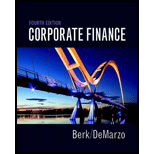
Corporate Finance (4th Edition) (Pearson Series in Finance) - Standalone book
4th Edition
ISBN: 9780134083278
Author: Jonathan Berk, Peter DeMarzo
Publisher: PEARSON
expand_more
expand_more
format_list_bulleted
Question
Chapter 16, Problem 4P
a)
Summary Introduction
To discuss: Whether Company CS or Company I is most expected to experience a loss of consumers in the occurrence of financial distress.
Introduction:
The financial distress could be a condition where a corporation cannot meet or has an issue paying off its financial obligations to its creditors.
b)
Summary Introduction
To discuss: Whether the Company “AL” or Company “A” type is most expected to experience a loss of consumers in the happening of financial distress.
Introduction:
The financial distress could be a condition where a corporation cannot meet or has issue paying off its financial obligations to its creditors.
Expert Solution & Answer
Want to see the full answer?
Check out a sample textbook solution
Students have asked these similar questions
What is the difference between a contra asset account and a liability?i need help.
What is the significance of a company’s price-to-earnings (P/E) ratio? i need answer.
What is the significance of a company’s price-to-earnings (P/E) ratio?
Chapter 16 Solutions
Corporate Finance (4th Edition) (Pearson Series in Finance) - Standalone book
Ch. 16.1 - Prob. 1CCCh. 16.1 - Does the risk of default reduce the value of the...Ch. 16.2 - If a firm files for bankruptcy under Chapter 11 of...Ch. 16.2 - Why are the losses of debt holders whose claims...Ch. 16.3 - Prob. 1CCCh. 16.3 - True or False: If bankruptcy costs are only...Ch. 16.4 - Prob. 1CCCh. 16.4 - According to the trade-off theory, all else being...Ch. 16.5 - Prob. 1CCCh. 16.5 - Why would debt holders desire covenants that...
Ch. 16.6 - Prob. 1CCCh. 16.6 - Prob. 2CCCh. 16.7 - Coca-Cola Enterprises is almost 50% debt financed...Ch. 16.7 - Why would a firm with excessive leverage not...Ch. 16.7 - Describe how management entrenchment can affect...Ch. 16.8 - How does asymmetric information explain the...Ch. 16.8 - Prob. 2CCCh. 16.9 - Prob. 1CCCh. 16.9 - Prob. 2CCCh. 16 - Gladstone Corporation is about to launch a new...Ch. 16 - Baruk Industries has no cash and a debt obligation...Ch. 16 - When a firm defaults on its debt, debt holders...Ch. 16 - Prob. 4PCh. 16 - Prob. 5PCh. 16 - Suppose Tefco Corp. has a value of 100 million if...Ch. 16 - You have received two job offers. Firm A offers to...Ch. 16 - As in Problem 1, Gladstone Corporation is about to...Ch. 16 - Kohwe Corporation plans to issue equity to raise...Ch. 16 - Prob. 10PCh. 16 - Prob. 11PCh. 16 - Hawar International is a shipping firm with a...Ch. 16 - Your firm is considering issuing one-year debt,...Ch. 16 - Marpor Industries has no debt and expects to...Ch. 16 - Real estate purchases are often financed with at...Ch. 16 - On May 14, 2008, General Motors paid a dividend of...Ch. 16 - Prob. 17PCh. 16 - Consider a firm whose only asset is a plot of...Ch. 16 - Prob. 19PCh. 16 - Prob. 20PCh. 16 - Prob. 21PCh. 16 - Consider the setting of Problem 21 , and suppose...Ch. 16 - Consider the setting of Problems 21 and 22, and...Ch. 16 - You own your own firm, and you want to raise 30...Ch. 16 - Empire Industries forecasts net income this coming...Ch. 16 - Ralston Enterprises has assets that will have a...Ch. 16 - Prob. 27PCh. 16 - If it is managed efficiently, Remel Inc. will have...Ch. 16 - Which of the following industries have low optimal...Ch. 16 - According to the managerial entrenchment theory,...Ch. 16 - Info Systems Technology (IST) manufactures...Ch. 16 - Prob. 32PCh. 16 - Prob. 33P
Knowledge Booster
Learn more about
Need a deep-dive on the concept behind this application? Look no further. Learn more about this topic, finance and related others by exploring similar questions and additional content below.Similar questions
arrow_back_ios
SEE MORE QUESTIONS
arrow_forward_ios
Recommended textbooks for you
- Business/Professional Ethics Directors/Executives...AccountingISBN:9781337485913Author:BROOKSPublisher:Cengage
 Auditing: A Risk Based-Approach (MindTap Course L...AccountingISBN:9781337619455Author:Karla M Johnstone, Audrey A. Gramling, Larry E. RittenbergPublisher:Cengage Learning
Auditing: A Risk Based-Approach (MindTap Course L...AccountingISBN:9781337619455Author:Karla M Johnstone, Audrey A. Gramling, Larry E. RittenbergPublisher:Cengage Learning

Business/Professional Ethics Directors/Executives...
Accounting
ISBN:9781337485913
Author:BROOKS
Publisher:Cengage

Auditing: A Risk Based-Approach (MindTap Course L...
Accounting
ISBN:9781337619455
Author:Karla M Johnstone, Audrey A. Gramling, Larry E. Rittenberg
Publisher:Cengage Learning

Current assets and current liabilities; Author: The Finance Storyteller;https://www.youtube.com/watch?v=Jw4TaiP42P4;License: Standard youtube license